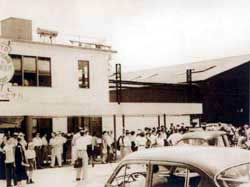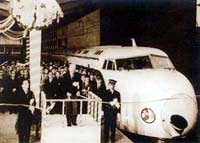 |
| Japan's transport system was formed as follows under the socio-economic conditions of 1). | |
| 1.
The expansion of transportation ability was a topic of priority so as to stop it from becoming a bottleneck for economic development. The country progressed forward with transportation infrastructure at a rapid pitch and the managerial stability of each area of business within it was sought by implementing supply and demand adjustment regulations. This saw Japan secure a stable supply of transport service and as such stimulated equipment investment in all transport modes on land, sea and air and meant that Japan's transportation strength increased. |
|
 The Tokyo International Airport Terminal upon completion |
|
| 2. Looking at each mode of transportation separately, our rail and sea transport modes have developed suited to the geographical conditions and were established before the war. As a result, Japan has realized a large-scale transport system that is effective in the fields of distribution trunk lines and Urban Areas1 passenger transport. Furthermore, transport services in Japan have been provided under sound business administration that set independent self-sustenance as a rule. This is one area in which we can be proud when comparing systems with the West. 3. Next, in conjunction with the development of road and airport facilities, superior convenience in motor vehicle2 transport and high-speed air transport rapidly increased as they engaged in competition with conventional modes of transport. |
|
Opening of the Tokaido Shinkansen Line |
 |
In October 1964 - the year of the Tokyo Olympics - the Tokaido Shinkansen began business with its 4 hour 'Hikari Super Express' and 5 hour 'Kodama Super Express' services between Tokyo and Shin-Osaka. This service added remarkable transport capacity. |
| Tape cut in front of the first Shinkansen |
|
|
PREVIOUS |
|
TOP |
|